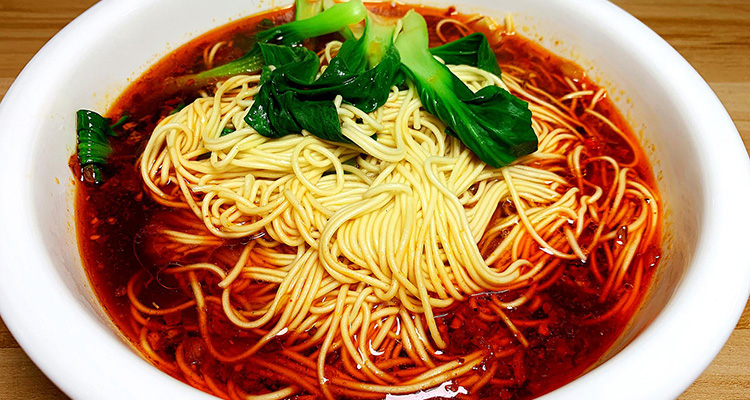Chongqing Xiao Mian: Spicy Noodle Soul
Imagine a foggy morning in Chongqing, the steep streets just waking up and vendors already arranging steaming bowls at roadside stalls. In the city, a simple bowl of Chongqing Xiao Mian is more than breakfast — it’s a daily ritual, a burst of flavor that wakes the senses and fuels the day. For travelers seeking authentic Chongqing cuisine and street food, tasting Xiao Mian is essential.
1.Origins and Cultural Roots
Chongqing Xiao Mian grew out of the city’s river-port and working-class culture. Longshoremen and laborers needed an affordable, warming meal that could be prepared quickly. The result was a plain noodle elevated by a complex, bold seasoning mix — the soul of Xiao Mian. Over time, this humble dish became a local icon, embraced by everyone from dockworkers to urban professionals.
Why locals love it: Xiao refers to modesty, not size. The dish’s true power comes from its seasoning — a layered blend of chili oil, Sichuan pepper, soy, vinegar, and other condiments that creates the characteristic mala — numbing and spicy — profile.
Key Ingredients and the ‘Soul’ of the Bowl
A great Chongqing noodle relies on balance, not expensive toppings. The most important parts are:
- Noodles: usually fresh alkaline noodles with a springy, chewy texture that holds up to hot broth or oily sauces.
- Chili oil (you you la zi): made from different dried chilies, toasted sesame, and carefully heated oil to release aroma without burning. This gives the dish its red, glossy look and fragrant heat.
- Sichuan pepper (hua jiao): provides the numbing ‘ma’ sensation. Quality pepper yields a floral, lingering numbness that complements the chili.
- Aromatics and condiments: minced garlic and ginger water, sesame paste for richness, soy sauce, vinegar, scallions, pickled mustard greens (zha cai), crushed peanuts, and sometimes pork lard or vegetable oil.

2.Types and How It’s Served
Chongqing Xiao Mian comes mainly in two styles:
- Soup noodle (tang mian): a comforting version with a clear, fragrant broth.
- Dry-mixed (gan liu or ban mian): no soup; the concentrated sauce clings to the noodles and delivers bolder flavor.
Customization is part of the fun. In local lingo you can ask for:
- “gan liu” (干溜) — dry-mixed style
- “ti huang” or “ti huang” (提黄) — slightly firmer noodles
- “jia qing” (加青) — extra vegetables
- “zhong la” (重辣) — extra chili oil
- “shao ma” (少麻) — less Sichuan pepper if you don’t like the numbing sensation
3.How it’s made (what to watch for)
- The seasoning bowl: the cook layers many condiments into the bowl in a precise order — this is where most shops differ and where the flavor is won or lost.
- Boiling the noodles: noodles are cooked briefly in rolling water with a few greens.
- Pouring the hot broth or water over the seasoning: the heat blooms the oils and aromatics, releasing the full aroma at the table.

4.Taste and Texture
On the first sip and slurp, you’ll notice the aromatic heat of the chili oil, followed by the tingling ma from Sichuan pepper, then the chewy, satisfying bite of the noodles. The interplay of salty, spicy, umami, and slightly tangy notes makes Xiao Mian addictive — spicy and invigorating but not just heat for heat’s sake.
5.How to Order Like a Local
Start with a milder level if you’re unsure: order a soup Xiao Mian at mild or medium spice. If you love intense flavors, try the dry-mixed “gan liu” and ask for “zhong la.” Use the local terms to customize:
- “Tang mian, zhong la” — soup noodles, medium spicy
- “Gan liu, ti huang, jia qing” — dry-mixed, firmer noodles, extra vegetables
- “Shao ma” — less numbing
6.Where to Eat and When
The most authentic bowls are often found in small roadside stalls, neighborhood noodle shops, and busy morning markets. Don’t be fooled by simple decor — the busiest shops with local queues usually indicate the best flavor. Many classic shops sell out by early afternoon, so breakfast and lunch are the prime times.
Pairings and Practical Tips
- Drink pairing: a cold soy milk or chilled sour plum drink (suanmeitang) helps cool your palate.
- Napkins and water: you’ll want both; the chili oil can be messy and the heat may make you sweat.
- Brave the red color: real Chongqing chili oil is aromatic and layered, not just pure heat. Start moderate and adjust as you learn your tolerance.

7.Simple Home Version
To recreate the spirit at home: combine minced garlic, scallions, crushed peanuts, soy sauce, vinegar, sesame paste, and a spoonful of store-bought chili oil. Boil alkaline or egg noodles with a few greens, ladle some hot noodle water or broth into the seasoning bowl, then add the noodles and mix well.
8.Final Note for Travelers
A bowl of Chongqing Xiao Mian is an easy entry into the city’s bold culinary world. It tells a story of history, community, and flavor ingenuity. After a night exploring Hongya Cave or a ride on the Yangtze Cable Car, find a crowded local noodle shop and order a bowl — that’s when you’ll taste Chongqing’s true, spicy soul.


